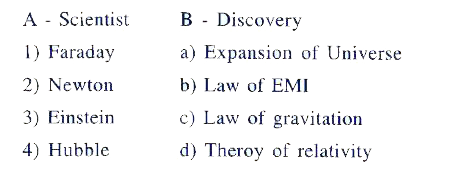Describe the progress made in the discovery and understanding of enzymes.
Step-by-Step Solution:
1. Introduction to Enzymes:
- Enzymes are biological molecules that act as catalysts in various biochemical reactions. They are primarily composed of proteins.
2. Discovery of Enzymes:
- The first enzyme to be discovered was diastase, identified by the French chemist Anselmey Payen in 1833. This marked the beginning of the study of enzymes and their functions.
3. Understanding the Function of Enzymes:
- Enzymes function as biocatalysts, meaning they accelerate chemical reactions. They can increase the rate of reactions significantly, sometimes making reactions occur millions of times faster than they would without the enzyme.
4. Commercial Applications of Enzymes:
- Enzymes have practical applications in various industries. For instance:
- They are used in the synthesis of antibiotics, which are crucial for treating bacterial infections.
- Enzymes are also utilized in biological washing powders, enhancing the effectiveness of cleaning by breaking down stains.
5. Advancements in Enzyme Research:
- Over the years, research has expanded our understanding of enzymes, including their structure, mechanisms of action, and the specific conditions under which they operate best (such as temperature and pH).
6. Conclusion:
- The discovery and understanding of enzymes have progressed significantly since their initial identification. Their role as biocatalysts and their applications in various fields highlight their importance in both biological processes and industrial applications.
- Enzymes are biological molecules that act as catalysts in various biochemical reactions. They are primarily composed of proteins.
- The first enzyme to be discovered was diastase, identified by the French chemist Anselmey Payen in 1833. This marked the beginning of the study of enzymes and their functions.
- Enzymes function as biocatalysts, meaning they accelerate chemical reactions. They can increase the rate of reactions significantly, sometimes making reactions occur millions of times faster than they would without the enzyme.
- Enzymes have practical applications in various industries. For instance:
- They are used in the synthesis of antibiotics, which are crucial for treating bacterial infections.
- Enzymes are also utilized in biological washing powders, enhancing the effectiveness of cleaning by breaking down stains.
- Over the years, research has expanded our understanding of enzymes, including their structure, mechanisms of action, and the specific conditions under which they operate best (such as temperature and pH).
- The discovery and understanding of enzymes have progressed significantly since their initial identification. Their role as biocatalysts and their applications in various fields highlight their importance in both biological processes and industrial applications.
Topper's Solved these Questions
- BIOMOLECULESBOOK - ICSECHAPTER - BIOMOLECULESEXERCISE - TEST YOUR PROGRESS (SHORT/LONG ANSWER TYPE QUESTIONS)
1 Video
- BIOMOLECULESBOOK - ICSECHAPTER - BIOMOLECULESEXERCISE - TEST YOUR PROGRESS (HIGHER ORDER THINKING SKILLS QUESTIONS)
8 Videos
- BIOMOLECULESBOOK - ICSECHAPTER - BIOMOLECULESEXERCISE - TEST YOUR PROGRESS (VERY SHORT ANSWER TYPE QUESTIONS)
77 Videos
- BIOLOGY ISC SAMPLE QUESTION PAPER 2019BOOK - ICSECHAPTER - BIOLOGY ISC SAMPLE QUESTION PAPER 2019EXERCISE - PART-II (SECTION -C)
6 Videos
- BODY FLUIDS AND CIRCULATIONBOOK - ICSECHAPTER - BODY FLUIDS AND CIRCULATIONEXERCISE - DIFFRENTIATE BETWEEN
13 Videos
Similar Questions
Describe the experiment which led to the discovery of the proton.
View SolutionDescribe the important properties of enzymes.
View SolutionThe discovery of CV. Raman is
View SolutionMatch the scientist's name against discovery

View SolutionDefine enzyme. Describe in brief the structure and characteristics of enzymes.
View SolutionWhat is the discovery of C.V. Raman ?
View SolutionThe fungus associated with discovery and source of gibberellins is
View SolutionScientist credited with discovery of sphaerosome is
View SolutionRutherford's experiment led to the discovery of
View SolutionWhat idea lead to the discovery of Xenon fluorides?
View Solution
